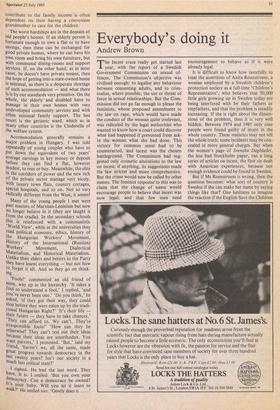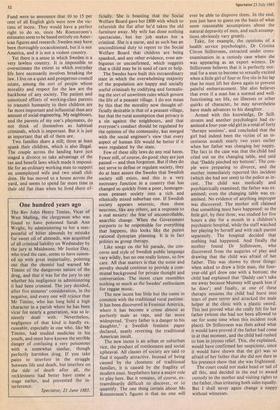Everybody's doing it
Andrew Brown
'The Incest craze really got started last 1. year, with the report of a Swedish Government Commission on sexual of- fences. The Commission's objective was civilised enough: to legalise any behaviour between consenting adults, and to crim- inalise, where possible, the use or threat of force in sexual relationships. But the Com- mission did not go far enough to please the feminists, whose proposed amendment to the law on rape, which would have made the conduct of the woman quite irrelevant, was ridiculed by the legal authorities who wanted to know how a court could discover what had happened if prevented from ask- in the woman what she had done. This victory for common sense had to be counteracted, and incest was the chosen battleground. The Commission had sug- gested only cosmetic alterations to the law on incest; if anything, its suggestions made the law stricter and more comprehensive. But the crime would now be called by other names. The feminist response to this was to claim that the change of name would encourage people to believe that incest was now legal; and that few men need
encouragement to behave as if it were already legal.
It is difficult to know how tastefully to treat the assertions of Anita Roenstroem, a woman employed by a Swedish children's protection society as a full-time 'Children's Representative', who believes that 50,000 little girls growing up in Sweden today are being interfered with by their fathers or stepfathers, and that the problem is steadily increasing. If she is right about the dimen- sions of the problem, then it is very well hidden. Between 1974 and 1981 only nine people were found guilty of incest in the whole country. These statistics may not tell the whole truth: some incidents may be con- cealed in more general charges. But when the women's page of Svenska Dagbladet, the less bad Stockholm paper, ran a long series of articles on incest, the first six dealt with American experiences, because not enough evidence could be found in Sweden.
But if Ms Roenstroem is wrong, then the question becomes: what sort of country is Sweden if she can make her name by saying things like that? One hesitates to imagine the reaction if the English Save the Children
Fund were to announce that 10 to 15 per cent of all English girls were now the vic- tims of incest. They would have a perfect right to do so, since Ms Roenstroem's estimates seem to be based entirely on Amer- ican figures and research. Sweden may have been thoroughly cocacolonised, but it is not America, and it is not a violent country.
Yet there is a sense in which Sweden is a very lawless country. It is impossible to overestimate the extent to which everyday life here necessarily involves breaking the law. I live on a quiet and prosperous council estate, among the sort of people whose morality and respect for the law are the backbone of any society. The patient and unnoticed efforts of working-class parents to transmit humanity to their children are far more important and influential than any amount of social engineering. My neighbours, and the parents of my son's playmates, do not think of themselves as habitual criminals, which is important. But it is just as important that all of them are.
Two families share a still; three at least spank their children, which is also illegal. The couple across the landing have just staged a divorce to take advantage of the tax and benefit laws which made it impossi- ble for an ordinary working man to support an unemployed wife and two small chil- dren. He has moved to a house across the yard, and seems to spend far more time in their old flat than when he lived there of- ficially. She is boasting that the Social Welfare Board gave her £800 with which to refurnish the flat after he'd taken the old furniture away. My wife has done nothing spectacular, but her job makes her a criminal. She is a nurse, and as such has an unconditional duty to report to the Social Welfare Board that children are being spanked, and any other evidence, even am- biguous or unconfirmed, which suggests that a child may be in need of care or help. The Swedes have built this extraordinary state in which the overwhelming majority of the population are happy and socially useful criminals by codifying and formalis- ing the sort of unwritten rules which govern the life of a peasant village. I do not mean by this that the morality now thought of- ficially desirable is that of a peasant village, but that the rural assumption that privacy is a sin against the neighbours, and that everyone's conduct should be regulated by the opinion of the community, has merged with the social engineer's view that every aspect of human life would be better if it were regulated by the state.
Few of these silly laws do any real harm. Fewer still, of course, do good: they are just passed — and then forgotten. But if they do not serve to define or regulate society, they do at least assure the Swedes that Swedish society still exists, and this is a very necessary function in a country that has changed so quickly from a poor, homogen- eous peasant society into a rich and ethnically mixed suburban one. If Swedish society appears neurotic, then these neuroses, like any others, are a response to a real anxiety: the fear of uncontrollable, anarchic change. When the Government purports to be responsible for everything that happens, this looks like the purest rational dystopian planning. It is in fact politics as group therapy.
Like songs on the hit parade, the con- cerns and style of Swedish public language vary wildly, but no one really listens, so few care. All that matters is that the noise and novelty should continue to provide a com- munal background for private thought and conversation. The incest craze resembles nothing so much as the Swedes' enthusiasm for reggae music.
The new incest has little but the name in common with the traditional rural pastime.
It has been discovered in Feminist America, where it has become a crime almost as perfectly male as rape, and far more widespread. 'Every father is a danger to his daughter,' a Swedish feminist paper declared, neatly reversing the traditional American insult.
The new incest is an urban or suburban vice, the product of rootlessness and social upheaval. All classes of society are said to find it equally attractive. Instead of being caused by the closeness of traditional families, it is caused by the fragility of modern ones. Stepfathers have a major role to play here. But it remains, of course, ex- traordinarily difficult to discover, or to quantify. The one thing certain about Ms Roenstroem's figures is that no one will ever be able to disprove them. In the end, you just have to guess on the basis of what seem reasonable assumptions about the natural depravity of men, and such assump- tions obviously vary greatly.
Take, for example, the opinions of a health service psychologist, Dr Cristina Citron Stillstroem, extracted under cross- examination in a custody case where she was appearing as an expert witness. Dr Stillstroem believes that it is perfectly nor- mal for a man to become so sexually excited when a little girl of four or five sits in his lap that he must lift her down again to prevent painful embarrassment. She also believes that even if a man has a normal and well- functioning sex life, no illnesses or other quirks of character, he may nevertheless have made advances to his daughter.
Armed with this knowledge, Dr Still- stroem and another psychologist had ex- amined a four-year-old girl in a total of forty 'therapy sessions', and concluded that the girl had indeed been the victim of an in- cestuous assault nearly two years earlier when her father was changing her nappy. The fact in the case was that the child had cried out on the changing table, and said that 'Daddy pinched my bottom'. The cou- ple were preparing to divorce, and the mother immediately reported this incident (which she had not seen) to the police as in- cest. The child was medically and psychiatrically examined; the father was ex- amined; even the changing table was ex- amined. No evidence of anything improper was discovered. The mother still claimed that something must have happened: so the little girl, by then three, was studied for five hours a day for a month in a children's psychiatric hospital, while the staff watched her playing by herself and with each parent separately. The hospital decided that nothing had happened. And finally the mother found Dr Stillstroem, who discovered from the auguries of play and drawing that the child was afraid of her father. This was shown by three things: when asked to draw a little man, the four- year-old girl drew one with a bottom; the child had explained that 'Daddy can't take me away because Mummy will spank him if he does'; and finally, at one of these therapy sessions the child had burst into tears of pure terror and attacked the male helper at the clinic with a plastic sword. This last proved what she really felt for her father (whom she had not been allowed to see for some time when this incident took place). Dr Stillstroem was then asked what it would have proved if the father had come in at that moment, and the child had rushed to him in joyous relief. This, she explained, would have confirmed her suspicions, since it would have shown that the girl was so afraid of her father that she did not dare in his presence show that she was frightened.
The court could not make head or tail of all this, and decided in the end to award custody to the mother and visiting rights to the father, thus irritating both sides equally. But I shall never again change a nappy without witnesses.







































 Previous page
Previous page